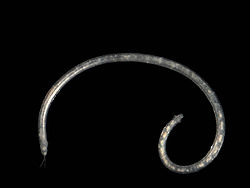| Polychaetes | |
|---|---|
 | |
| An image of Polygordius appendiculatus, an archiannelid species. | |
| Scientific classification | |
| Kingdom: | |
| Phylum: | Annelida |
| Class: | Polychaeta |
| Order: | Haplodrili Lankester, unknown date |
| Families [1] | |
| Dinophilidae | |
| Synonyms | |
| Archiannelida Hatschek, 1878 | |
Haplodrili, or Archiannelida, is an order of primitive polychaete worms. Zoologist Ray Lankester gave it the name haplodrili, while zoologist Berthold Hatschek later named it Archiannelida. Once considered to be a class under Annelida, and even a separate phylum, Haplodrili is now widely accepted to be an order under Polychaeta.[2] Species in this order are known for completely lacking external segments.
Overview
Polygordius and Protodrilus live in sand, but while the former moves by means of the contraction of its body-wall muscles, Protodrilus can progress by the action of the bands of cilia surrounding its segments, and of the longitudinal ciliated ventral groove. Saccocirrus, which also lives in sand, and more closely resembles the Polychaeta, has throughout the greater length of its body on each segment a pair of small uniramous parapodia bearing a bunch of simple setae. No other member of the group is known to have any trace of setae or parapodia at any stage of development.[3]
Commonality
These three genera have the following characters in common. The body is small and resembles polychaete larvae; the epidermis is ciliated; the number of segments varies from five and up, or can be completely absent; small prostomium with or without appendages; parapodia absent; septa reduced or absent; the nervous system consists of a brain and longitudinal ventral nerve cords closely connected with the epidermis (without distinct ganglia); this is widely separated in Saccocirrus, closely approximated in Protodrilus, and fused together in Polygordius; the coelom is well developed and the dorsal and ventral longitudinal mesenteries are complete; the nephridia are simple, and open into the coelom. Polygordius differs from Protodrilus and Saccocirrus in the absence of a distinct suboesophageal muscular pouch, and in the absence of a peculiar closed cavity in the head region, which is especially well developed in Saccocirrus, and probably represents the specialized coelom of the first segment. Moreover, in Saccocirrus the genital organs, present in the majority of the trunk segments, have become much more complicated. In the female, every fertile segment has a pair of spermathecae opening at the nephridiopores. In the male, every genital segment has a right and a left protrusible penis, into which both the nephridium and a sperm-sac open. The wide funnels of the nephridia of this region are possibly of coelomic origin.[3]
See also
References
- ^ Fauchald, K. (1977). The polychaete worms, definitions and keys to the orders, families and genera. Natural History Museum of Los Angeles County: Los Angeles, CA (USA), Science Series 28: 1–188, P. 152–155. The full text
- ^ WoRMS (2004). Read G, Fauchald K (eds.). "Archiannelida". World Polychaeta database. World Register of Marine Species. Retrieved 2014-01-15.
- ^ a b
 One or more of the preceding sentences incorporates text from a publication now in the public domain: Goodrich, Edwin Stephen (1911). "Haplodrili". In Chisholm, Hugh (ed.). Encyclopædia Britannica. 12 (11th ed.). Cambridge University Press. pp. 933–934.
One or more of the preceding sentences incorporates text from a publication now in the public domain: Goodrich, Edwin Stephen (1911). "Haplodrili". In Chisholm, Hugh (ed.). Encyclopædia Britannica. 12 (11th ed.). Cambridge University Press. pp. 933–934.
External links